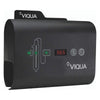
Reliable UV Monitoring for Trojan UVMAX Systems
, by EVIMERO-DEV, 6 min reading time

, by EVIMERO-DEV, 6 min reading time
In today's world, maintaining clean and safe water is essential, and understanding how to monitor and manage ultraviolet (UV) systems plays a crucial role in ensuring this purity. The importance of reliable UV monitoring systems cannot be overstated, especially when it comes to Trojan UVMAX and Viqua systems. These systems are designed to effectively disinfect water using UV light, which inactivates harmful microorganisms without the need for chemicals. By integrating regular monitoring and maintenance with components such as controllers and lamps, you can ensure optimal performance and safety of your water treatment systems.
UV lamps are integral to the functionality of water disinfection systems. They emit ultraviolet light that targets and deactivates the DNA of bacteria, viruses, and other microorganisms present in water. This process ensures that these pathogens cannot reproduce, effectively neutralizing any potential threats to health. Viqua 602806 UV Lamp, a critical component of E4 UV systems, exemplifies the efficacy of UV technology in maintaining clean water. 
However, while UV lamps like the Viqua 602805 UV lamp. are effective, one might wonder about their longevity and effectiveness. These lamps generally have a lifespan of about 9,000 hours, which translates to roughly a year of continuous usage. Product manufacturers also provide warranties, such as the 1-Year Pro-Rated Warranty with Viqua lamps, offering assurance to consumers about their durability and performance.
While UV lamps are critical, the UV controller is the backbone that ensures these lamps function optimally. For example, the Trojan UVMax 650733R-002 power supply controller is designed to control the voltage supplied to the UV system to maintain the correct operational conditions. 
The necessity of UV controllers extends beyond just operational efficiency. They often come equipped with features such as audible and visual replacement reminders, which can be vital in systems that require constant oversight. The integration of advanced monitoring capabilities into controllers, like the Viqua BA-ICE-CL controller, helps ensure that any issues are quickly identified and addressed, preventing long-term damage or inefficiency.
In the landscape of UV monitoring solutions, several factors determine the best choice for any given situation. These include the size of the system, water flow rate, and specific operational needs. Table 1 compares key features of popular UV monitoring systems, highlighting their capabilities and differences. This comparison can help consumers make informed decisions regarding which system to choose based on their individual requirements.
| Feature | Trojan UVMax 650733R-002 | Viqua BA-ICE-CL |
|---|---|---|
| Voltage Control | Highly precise | Electrical protection |
| System Compatibility | VIQUA D4 | Viqua VH200 & VH410 |
| Lamp Reminders | Yes | No |
Successful operation of a UV disinfection system goes beyond installation; it requires ongoing maintenance. Regular inspections and replacements of components, like the Viqua 602856 UV Lamp, ensure the continued efficacy of the system. 
While many users may question the frequency of maintenance activities, most manufacturers recommend an annual checkup at the very least. This entails replacing the UV lamp and cleaning the quartz sleeve to ensure maximum UV exposure. Without such preventative measures, there is a risk of reduced disinfection capability, which could compromise water safety.
Users often encounter challenges when operating UV systems, especially in recognizing when components need replacement. A common misconception is that a functioning UV lamp equates to effective disinfection. In reality, lamps experiencing a drop in UV intensity can fail to deactivate microorganisms even if they are still lit. Understanding these nuances can help prevent potential breakdowns and inefficiencies in UV monitoring systems. Similarly, the question often arises about the safety of UV systems; rest assured, operating these systems adheres to stringent safety standards that protect users and maintain water quality.
As technology advances, UV monitoring systems are expected to become even more sophisticated. The rise of smart systems that automatically track and report system health, combined with IoT capabilities, could revolutionize water treatment practices. This evolution could lead to more frequent, automated updates and maintenance, which would reduce manual intervention and enhance system reliability. The question remains about the costs involved; however, given the enhanced functionalities, the investment in such systems offers long-term benefits in ensuring water quality and safety.
Reliable UV monitoring and system maintenance are pivotal for ensuring the continued effectiveness of water disinfection systems. By understanding the integral roles of components like UV lamps and controllers, such as those provided by Trojan and Viqua, users can better manage their systems and ensure clean, safe water for their communities. Regular maintenance, coupled with an awareness of upcoming technological trends, positions users to take full advantage of the capabilities these systems offer, ensuring water safety now and in the future.